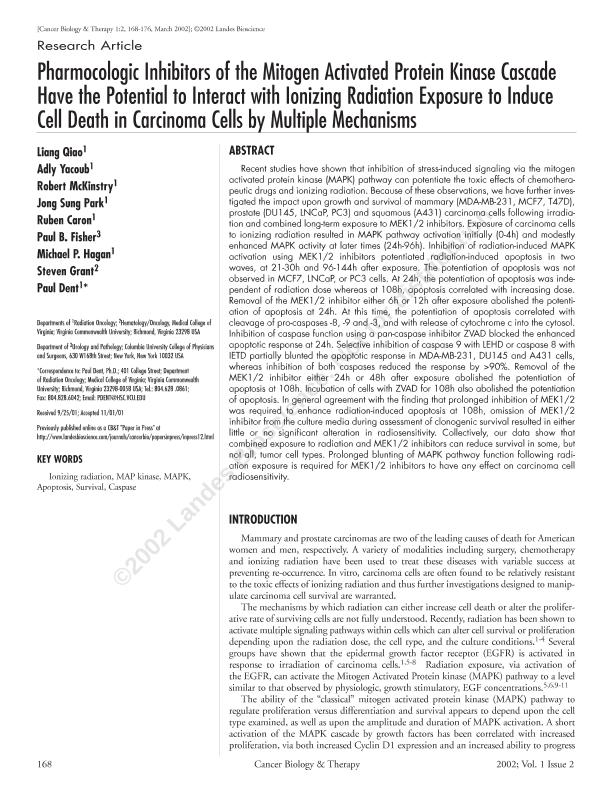Mostrar el registro sencillo del ítem
dc.contributor.author
Qiao, Liang
dc.contributor.author
Yacoub, Adly
dc.contributor.author
McKinstry, Robert
dc.contributor.author
Park, Jong Sung
dc.contributor.author
Caron, Ruben Walter

dc.contributor.author
Fisher, Paul B.
dc.contributor.author
Hagan, Michael P.
dc.contributor.author
Grant, Steven
dc.contributor.author
Dent, Paul
dc.date.available
2021-03-12T16:02:07Z
dc.date.issued
2002-12
dc.identifier.citation
Qiao, Liang; Yacoub, Adly; McKinstry, Robert; Park, Jong Sung; Caron, Ruben Walter; et al.; Pharmocologic inhibitors of the mitogen activated protein kinase cascade have the potential to interact with ionizing radiation exposure to induce cell death in carcinoma cells by multiple mechanisms; Taylor & Francis; Cancer Biology & Therapy; 1; 2; 12-2002; 168-176
dc.identifier.issn
1538-4047
dc.identifier.uri
http://hdl.handle.net/11336/128235
dc.description.abstract
Recent studies have shown that inhibition of stress-induced signaling via the mitogen activated protein kinase (MAPK) pathway can potentiate the toxic effects of chemotherapeutic drugs and ionizing radiation. Because of these observations, we have further investigated the impact upon growth and survival of mammary (MDA-MB-231, MCF7, T47D), prostate (DU145, LNCaP, PC3) and squamous (A431) carcinoma cells following irradiation and combined long-term exposure to MEK1/2 inhibitors. Exposure of carcinoma cells to ionizing radiation resulted in MAPK pathway activation initially (0-4h) and modestly enhanced MAPK activity at later times (24h-96h). Inhibition of radiation-induced MAPK activation using MEK1/2 inhibitors potentiated radiation-induced apoptosis in two waves, at 21-30h and 96-144h after exposure. The potentiation of apoptosis was not observed in MCF7, LNCaP, or PC3 cells. At 24h, the potentiation of apoptosis was independent of radiation dose whereas at 108h, apoptosis correlated with increasing dose. Removal of the MEK1/2 inhibitor either 6h or 12h after exposure abolished the potentiation of apoptosis at 24h. At this time, the potentiation of apoptosis correlated with cleavage of pro-caspases -8, -9 and -3, and with release of cytochrome c into the cytosol. Inhibition of caspase function using a pan-caspase inhibitor ZVAD blocked the enhanced apoptotic response at 24h. Selective inhibition of caspase 9 with LEHD or caspase 8 with IETD partially blunted the apoptotic response in MDA-MB-231, DU145 and A431 cells, whereas inhibition of both caspases reduced the response by >90%. Removal of the MEK1/2 inhibitor either 24h or 48h after exposure abolished the potentiation of apoptosis at 108h. Incubation of cells with ZVAD for 108h also abolished the potentiation of apoptosis. In general agreement with the finding that prolonged inhibition of MEK1/2 was required to enhance radiation-induced apoptosis at 108h, omission of MEK1/2 inhibitor from the culture media during assessment of clonogenic survival resulted in either little or no significant alteration in radiosensitivity. Collectively, our data show that combined exposure to radiation and MEK1/2 inhibitors can reduce survival in some, but not all, tumor cell types. Prolonged blunting of MAPK pathway function following radiation exposure is required for MEK1/2 inhibitors to have any effect on carcinoma cell radiosensitivity.
dc.format
application/pdf
dc.language.iso
eng
dc.publisher
Taylor & Francis

dc.rights
info:eu-repo/semantics/openAccess
dc.rights.uri
https://creativecommons.org/licenses/by-nc-sa/2.5/ar/
dc.subject
APOPTOSIS
dc.subject
CASPASE
dc.subject
IONIZING RADIATION
dc.subject
MAP KINASE
dc.subject
MAPK
dc.subject
SURVIVAL
dc.subject.classification
Otras Ciencias Médicas

dc.subject.classification
Otras Ciencias Médicas

dc.subject.classification
CIENCIAS MÉDICAS Y DE LA SALUD

dc.title
Pharmocologic inhibitors of the mitogen activated protein kinase cascade have the potential to interact with ionizing radiation exposure to induce cell death in carcinoma cells by multiple mechanisms
dc.type
info:eu-repo/semantics/article
dc.type
info:ar-repo/semantics/artículo
dc.type
info:eu-repo/semantics/publishedVersion
dc.date.updated
2021-01-18T15:48:23Z
dc.identifier.eissn
1555-8576
dc.journal.volume
1
dc.journal.number
2
dc.journal.pagination
168-176
dc.journal.pais
Reino Unido

dc.journal.ciudad
Londres
dc.description.fil
Fil: Qiao, Liang. Virginia Commonwealth University; Estados Unidos
dc.description.fil
Fil: Yacoub, Adly. Virginia Commonwealth University; Estados Unidos
dc.description.fil
Fil: McKinstry, Robert. Virginia Commonwealth University; Estados Unidos
dc.description.fil
Fil: Park, Jong Sung. Virginia Commonwealth University; Estados Unidos
dc.description.fil
Fil: Caron, Ruben Walter. Virginia Commonwealth University; Estados Unidos. Consejo Nacional de Investigaciones Científicas y Técnicas. Centro Científico Tecnológico Conicet - Mendoza. Instituto de Medicina y Biología Experimental de Cuyo; Argentina
dc.description.fil
Fil: Fisher, Paul B.. Columbia University. College of Physicians and Surgeons; Estados Unidos
dc.description.fil
Fil: Hagan, Michael P.. Virginia Commonwealth University; Estados Unidos
dc.description.fil
Fil: Grant, Steven. Virginia Commonwealth University; Estados Unidos
dc.description.fil
Fil: Dent, Paul. Virginia Commonwealth University; Estados Unidos
dc.journal.title
Cancer Biology & Therapy

dc.relation.alternativeid
info:eu-repo/semantics/altIdentifier/doi/https://doi.org/10.4161/cbt.64
dc.relation.alternativeid
info:eu-repo/semantics/altIdentifier/url/https://www.tandfonline.com/doi/abs/10.4161/cbt.64
Archivos asociados
